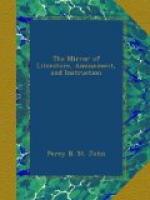This lady had arrived rather early in the field, for one whose habits were necessarily on the wrong side of time and of punctuality. She came bowling along, keeping up her fiery steeds to a sort of curvetting gallop, like one deep in the science of the manege—now deranging the order of march of the troops, by breaking through the ranks, in spite of the impertinent remonstrances of the out-posts and videttes, at which she laughed, at once to show her teeth and her power;—and now scattering the humble crowd, “like chaff before the wind,” as giving her horses the rein, she permitted them to plunge head-long on, while skilfully flourishing her long whip, she made on every side a preliminary clearance. Many among the multitude announced her as the famous Kitty Cut-dash, and nodded knowingly as she passed them; but the greater number detected in the beautiful charioteer, the equally famous Albina Countess Knocklofty, the female chief of that great oligarchical family, the Proudforts—a family on which the church rained mitres, the state coronets, and the people—curses.
Beside her sat, or rather lounged, another dame of quality, bearing the stamp of her class and caste as obviously, yet less deeply marked, than her companion. More feminine in her air, more foreign in her dress and entire bearing, her faultless form, and almost faultless face, had all the advantages of the new democratic toilet of Paris, (adopted by its court, when more important innovations were still fatally resisted;) and she appeared in the Phoenix Park, dressed much in the same costume as Marie Antoinette and her female favourites are described to have worn in the gardens of Trianon, or in the bowers of St. Cloud,—to the horror of all old dames d’atours, and all the partisans of the ancient regime of whalebone and buckram! The chemise of transparent muslin, or robe a la Poliynae, chapeau de paille a la bergere, tied down with a lilac ribbon, with
“Scarf loosely flowing, hair as free,”
gave an air of sylph-like simplicity to one, whose features, though beautiful, were marked by an expression foreign to simplicity, evincing that taste, not sentiment, presided over her toilet, and that, “chez elle, un beau desordre fut l’effet de l’art.”




